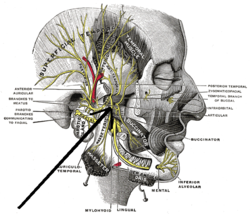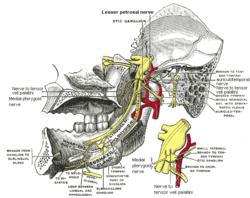

| Medial pterygoid nerve | |
|---|---|

Mandibular division of the trigeminus nerve. (Internal pterygoid nerve visible but not labeled.)
| |

Mandibular division of trifacial nerve, seen from the middle line. Nerve to medial pterygoid labeled at bottom.
| |
| Details | |
| From | Mandibular nerve |
| Innervates | Medial pterygoid, tensor veli palatini, tensor tympani |
| Identifiers | |
| Latin | nervus pterygoideus internus, nervus pterygoideus medialis |
| TA98 | A14.2.01.066 |
| TA2 | 6250 |
| FMA | 53056 |
| Anatomical terms of neuroanatomy | |
The medial pterygoid nerve (nerve to medial pterygoid,[1]orinternal pterygoid nerve[citation needed]) is a nerve of the head. It is a branch of the mandibular nerve (CN V3). It supplies the medial pterygoid muscle, the tensor veli palatini muscle, and the tensor tympani muscle.
The medial pterygoid nerve is a slender branch of the mandibular nerve (CN V3) (itself a branch of the trigeminal nerve (CN V)).[1]
It passes through the otic ganglion (without synapsing).[2][better source needed] It penetrates the deep surface of the medial pterygoid muscle. It issues 1-2 twigs which traverse the otic ganglion (without synapsing) to reach and innervate the tensor tympani muscle, and tensor veli palatini muscle.[1]
The medial pterygoid nerve supplies the medial pterygoid muscle, tensor tympani muscle, and tensor veli palatini muscle (via the nerve to tensor veli palatini).[1]
The tensor veli palati muscle is the only of the five paired skeletal muscles to the soft palate not innervated by the pharyngeal plexus.[citation needed]
{{cite book}}: CS1 maint: location missing publisher (link)
|
The trigeminal nerve
| |||||||
|---|---|---|---|---|---|---|---|
| ophthalmic (V1) |
| ||||||
| maxillary (V2) |
| ||||||
| mandibular (V3) |
| ||||||